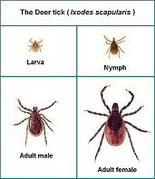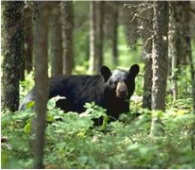Hiking opportunities in our area are many, but unfortunately so are some of the less desirable aspects. But with a little knowledge and some easy precautions, you can keep the hazards to a minimum and enjoy your hike.
The Trouble With Ticks

Ticks can carry serious illnesses, including Lyme Disease, and are VERY abundant in our area. While tick related diseases can be treated, prevention is always preferable.
Know where your enemy is hiding! Ticks are most common in grassy areas and high brush, and they lurk in heavily wooded areas as well. Since hikers can't avoid the woods, prevention is key.
Use repellent! DEET (20-30%) is the most reliable tick repellent, but may not be safe for children or sensitive skin. Picardin is another ingredient shown to be effective. Citronella, eucalyptus or rose geranium products offer a natural alternative, but may not be as effective. Whatever repellent you choose, make sure to reapply every several hours. Wearing enclosed shoes, light colored long sleeves and pants, and tucking pants into socks/boots also restricts the ticks' access.
Check yourself frequently on the trail and once you are finished, especially warm, moist areas (i.e. armpits, groin). Deer ticks can be as small as a poppy seed (nymphs), while adults are the size of apple seeds. Upon returning home, bathe or shower within 2 hours to remove unattached ticks and tumble clothes in the dryer on high heat for an hour. If you find an attached tick, don't panic; according to the CDC it takes 36-48 hours for it to be able to infect you. For instructions on removing an attached tick, click here.
Know where your enemy is hiding! Ticks are most common in grassy areas and high brush, and they lurk in heavily wooded areas as well. Since hikers can't avoid the woods, prevention is key.
Use repellent! DEET (20-30%) is the most reliable tick repellent, but may not be safe for children or sensitive skin. Picardin is another ingredient shown to be effective. Citronella, eucalyptus or rose geranium products offer a natural alternative, but may not be as effective. Whatever repellent you choose, make sure to reapply every several hours. Wearing enclosed shoes, light colored long sleeves and pants, and tucking pants into socks/boots also restricts the ticks' access.
Check yourself frequently on the trail and once you are finished, especially warm, moist areas (i.e. armpits, groin). Deer ticks can be as small as a poppy seed (nymphs), while adults are the size of apple seeds. Upon returning home, bathe or shower within 2 hours to remove unattached ticks and tumble clothes in the dryer on high heat for an hour. If you find an attached tick, don't panic; according to the CDC it takes 36-48 hours for it to be able to infect you. For instructions on removing an attached tick, click here.
Battling the Bugs
Bees, wasps, hornets & yellow jackets - They are attracted to bright colors and sweet smells, so it's best to wear pale colors and earthtones and avoid flowery or fruity smelling soaps, shampoos, lotions or fragrances. Be alert for nests in hollow trees, under logs and streambanks. Bees are attracted to swift movements; if you have an encounter, stay calm and move slowly.
Mosquitoes and flies - Wear insect repellent and cover exposed skin by wearing long-sleeved shirts, long pants, high socks and a cap. Steer clear of stagnant water or fields of damp grass, and avoid hiking during peak times. Mosquitoes prefer the cooler periods from dusk until dawn, and are scarcest during the heat of the day and when winds rise above 10 mph.
Mosquitoes and flies - Wear insect repellent and cover exposed skin by wearing long-sleeved shirts, long pants, high socks and a cap. Steer clear of stagnant water or fields of damp grass, and avoid hiking during peak times. Mosquitoes prefer the cooler periods from dusk until dawn, and are scarcest during the heat of the day and when winds rise above 10 mph.
Bear Necessities

If you see a bear:
Keep your distance, and be wary if it's a mother with cubs, as she may aggressively defend them. Even though your first instinct is to run, DON’T. They will perceive you as prey and they can run much faster then you (up to 35mph). They are natural climbers, so don't try to climb a tree. Don’t play dead, that may work with grizzly bears - but not black bears - and there are only black bears the New York and New Jersey area.
So what should you do?
Don't hike alone! Hiking in a group is safer - and gives you companions to share the experience with. Be sure to make some noise as you hike: talk, sing, or clap your hands to alert bears in the area to your presence. Make yourself look bigger by raising and waving your arms above your head - but don’t be overly aggressive and make sure not to corner them; make sure the bear has a clear escape route.
If the bear huffs, swats the ground or makes popping sounds by snapping it's jaw, these are signs you are too close. Slowly back away, do not make direct eye contact. If it stands on it's hind legs, it may be trying to detect scents or get a better view; it's not usually threatening behavior.
Want more information? Check out this fact sheet from the the NJ Department of Environmental Protection.
Keep your distance, and be wary if it's a mother with cubs, as she may aggressively defend them. Even though your first instinct is to run, DON’T. They will perceive you as prey and they can run much faster then you (up to 35mph). They are natural climbers, so don't try to climb a tree. Don’t play dead, that may work with grizzly bears - but not black bears - and there are only black bears the New York and New Jersey area.
So what should you do?
Don't hike alone! Hiking in a group is safer - and gives you companions to share the experience with. Be sure to make some noise as you hike: talk, sing, or clap your hands to alert bears in the area to your presence. Make yourself look bigger by raising and waving your arms above your head - but don’t be overly aggressive and make sure not to corner them; make sure the bear has a clear escape route.
If the bear huffs, swats the ground or makes popping sounds by snapping it's jaw, these are signs you are too close. Slowly back away, do not make direct eye contact. If it stands on it's hind legs, it may be trying to detect scents or get a better view; it's not usually threatening behavior.
Want more information? Check out this fact sheet from the the NJ Department of Environmental Protection.
Concerned about Poison Ivy? DON'T let it stop you from hitting the trail, but DO check out this information on recognizing, preventing and treating!
